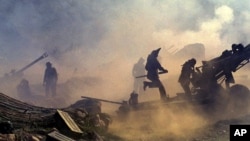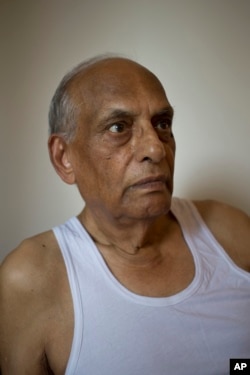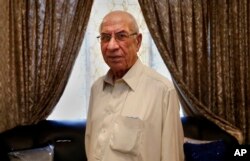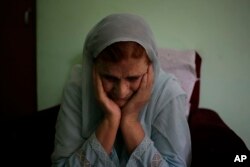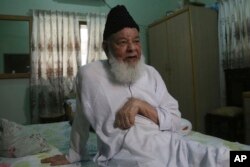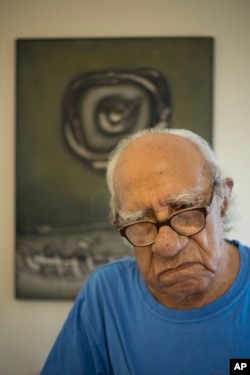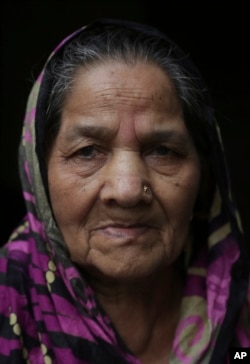It’s been 70 years since India and Pakistan were carved from the former British Empire as independent nations, a process that triggered one of the largest human migrations in history. Overnight, Hindu and Muslim neighbors became fearful of one another. Mob violence broke out, leaving hundreds of thousands dead. About 12 million people fled their homes, including Hindus afraid they would not be welcome in the newly declared Islamic state of Pakistan, and Muslims worried they’d suffer at the hands of India’s Hindu majority.
Here, survivors from both India and Pakistan recall living through that uneasy time, and consider what it meant to the future of the two countries.
ONE EVENING EVERYTHING CHANGED
On Aug. 14, 1947, the day of Pakistan’s independence, groups of Muslims marched through villages wearing the country’s newly created flags on their shoulders.
For some, it was a time of celebration. For Sohinder Nath Chopra and his Hindu family, it was time to flee.
A Muslim cleric urged the family to leave their ancient village in what is now western Pakistan. A Christian servant accompanied them as a guard.
“Our village had a family-type community,” recalls 81-year-old Chopra, who was 12 at the time. “There was always something going on, and life in that village was very good.”
Chopra’s family moved through refugee camps on both sides of the border, eventually reaching the bustling Indian capital of New Delhi. Chopra and his three brothers immersed themselves in their schoolwork, with Chopra and his eldest brother earning scholarships for post-graduate studies in Canada.
When he returned to India in 1973, the country was struggling with social unrest and extreme poverty. In the decades of economic growth and reform that have followed, India became more economically and politically stable, while seeing its population more than double to 1.3 billion. Chopra believes the country’s separation from Pakistan helped.
“It was a blessing in disguise. Although in the first 10 years or so, we felt very bitter about it,” he said.
He still dreams of visiting his old family home, but lingering fears and turbulent India-Pakistan relations have kept him from making the journey. His wife tries to console him by saying that everything he remembers has probably changed.
NEIGHBORS LYNCHED, HOUSES SMOLDERING
Every hour there was rumor of another attack. One Sikh man lynched by rampaging mobs of Muslims, another hacked to death in his own home. Mohammad Ishaq’s boyhood memories from Pakistan’s first days are filled with these images of killing and destruction.
“That was the time of extreme fear. Then only the men stayed in their homes. The women and children were sent to safer places,” he recalled.
In the early evenings, a silence would settle over his neighborhood in the old, congested city of Rawalpindi as no one dared to leave their homes. In the morning, they’d find other houses burned, smoldering.
Ishaq remembers mobs attacking three large houses belonging to wealthy Sikh families, whom many in the Muslim majority neighborhood resented. They ravaged and robbed the homes. They stabbed and hacked one homeowner to death. His body lay in the street for days.
“When I first saw the body, I turned pale and I was so scared that I didn’t dare come out of my home for many days,” Ishaq said.
He said poor Muslims were in the majority in his neighborhood, and both feared and envied their wealthy Sikh and Hindu neighbors. The creation of Pakistan as its own Islamic republic offered opportunities they otherwise wouldn’t have had, he said.
Today, he sees Pakistan’s biggest handicap as its rapid population growth, from about 45 million in 1960 to about 200 million today.
“The population continues to increase, and resources decrease, and it is because of this that as a country we could not achieve great progress,” he said.
A FAMILY MASSACRED
Shamsul Nisa was 10 when she watched her Muslim father, grandfather and six uncles killed by Hindu mobs in Udhampur, a southern town in the disputed Himalayan region of Kashmir.
“Our homes and our lives were destroyed. We were suddenly turned into beggars,” said Nisa, 80. She had escaped along with her mother and four brothers, and the family settled in Muslim-majority Srinagar, the main city on the Indian-controlled side of the still-divided territory.
India and Pakistan have fought two of their three wars over control of Kashmir. Today, they each administer part of it, separated by a heavily militarized line of control. A third, smaller portion is controlled by China.
In the chaos of those first days, when ancient principalities were pledging to join one of the two nations, Kashmir’s final status was by no means certain. The Muslim majority rose up repeatedly against the Hindu Maharaja and his plans to remain independent. Pakistani tribesmen raided in an effort to wrest control; India marched troops into the region with a promise to keep the peace and to hold a referendum. Tens of thousands of Muslims were slaughtered by Hindu mobs in the southern Jammu region, while hundreds of thousands more were driven from their homes to Pakistan or Pakistani-controlled Kashmir.
Until Partition, “Kashmir was not divided,” Nisa said. “But whosoever could, grabbed and occupied parts of it.”
Nisa eventually became a teacher, married and had three daughters and a son. Since the recent death of her husband, she remains with her son. “I can’t stay alone” since those violent days in 1947, she said. “My heart palpitates with pain.”
She still believes Partition was the right move for South Asia — if only Kashmir could decide its own affiliation.
“I think it was a right decision, and we also say that Kashmir should be freed (from India).”
“IT NEEDN’T HAVE HAPPENED”
Krishen Khanna was 21 when his father declared one night, “We’ve got to move.” Khanna imagined his family was taking a vacation when they hurriedly left their home in Lahore, their belongings scattered across the front lawn.
“I wasn’t told at the time, on our way out, that we were saving our lives,” said Khanna, now 92 and living in New Delhi. Only later did he learn that one of his father’s co-workers had warned that his family could become easy targets post-Partition.
In the end, the splintering of the subcontinent would leave nearly a million people dead in its wake, and around 15 million people displaced.
“Historically, it needn’t have happened,” he said. He believes the process was unnecessarily rushed. “A few more years could have spared the kind of trouble and the kind of hatred and the kind of mess that went on.”
Partition led Khanna to search for work in Mumbai, where he turned his love for visual arts into a career as a painter. He submitted his first piece for an exhibition the next year — a painting depicting Hindus and Muslims together reading a newspaper story about the assassination of India’s independence leader, Mahatma Gandhi.
Some of his work since has explored the themes of displacement and anxiety. He said the idea of dividing people by religion was ludicrous.
“You think Hindus and Muslims only have bloody guns pointing at each other? No, they don’t.”
LUGGAGE LEFT ON THE ROADS
Shamim Uddin remembers the tortuous journey made with his young wife and child from what is now the Indian state of Uttar Pradesh — so many train rides, long hot days on buses and hours of walking until they reached Pakistan in 1950.
Communal rioting had broken out, with mobs of Hindus and Muslims fighting each other and terrorizing people.
“Muslims did not feel safe anymore,” even in the Muslim-majority area he was from, the 89-year-old said in his home in Karachi. “Everyone’s luggage was on the roads. Five generations of culture and tradition, basically, was being sold on the streets.”
Uddin found work at one oil company, then worked for another until his retirement. He now lives with his wife, two sons and seven grandchildren. Another five daughters are married and live elsewhere.
He laments that younger generations don’t know or appreciate the sacrifices and hardships endured by his generation in creating Pakistan.
One of his most prized possessions is a portrait of Muhammad Ali Jinnah, the country’s founding father or ‘Quaid-e-Azam,’ as he is known. Uddin lectured on Jinnah’s teachings to Pakistan’s young for years until a stroke forced him to stop.
REFUGEES IN THEIR OWN COUNTRY
Partition left Hira Gulrajani and his wealthy Hindu family feeling there was nowhere they belonged, though they had initially welcomed the news of India and Pakistan gaining independence from the British Empire after decades of struggle.
“It was one big miserable story,” he said.
Mobs littered the streets in their hometown of Karachi with pages from Sikhism’s holy book, Guru Granth Sahib. People who avoided stepping on them were accused of being non-Muslims and were attacked with knives or swords, he said. Both Hindus and Sikhs would consider the book to be holy.
“I saw what was happening,” Gulrajani said. “I don’t feel that bad for having lived through that episode by walking over those pages.”
In January 1948, his family left Karachi and boarded a ship to the south Indian port city of Madras, now called Chennai. When they arrived, they were considered refugees.
“In our own country, India ... we were called Pakistanis. That hurt,” he said. Never finding a place where they felt welcome, they moved several times before finally settling in New Delhi.
Gulrajani believes Partition never should have happened.
“Was this type of independence necessary?” he asked rhetorically. “We had imagined an independence where we would be rid of the foreign forces, but not that we would have to fight among ourselves.”
SAVED BY HINDU VILLAGERS
Akhtari Begum was spared many of the horrors that haunt Partition survivors thanks to the Hindu villagers who hid her away from marauding mobs and kept her safe.
The Muslim woman lived peacefully among her Hindu neighbors in northern India for a decade, until her husband persuaded her to move to the eastern Pakistani city of Lahore. The move was meant to be temporary. But plans to visit India for family funerals or friends’ weddings evaporated when souring relations between India and Pakistan made obtaining a travel visa almost impossible.
Six decades later, Begum said she has only one dream: for the two countries to build strong, friendly ties.
“I want peaceful relations between Pakistan and India,” said the 88-year-old woman, who leans on a walker as she moves slowly through the abandoned school that has become her home since she and some 60 other migrants moved in after Partition.
She said her husband, a laborer who died a few years ago, never built them a house, saying: “One day, we will go back to our village, so why do we need a home here?”
They never imagined it would be so difficult to go back.




